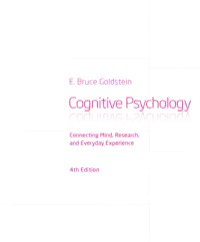
Cognitive Psychology: Connecting Mind, Research and Everyday Experience PDF
Preview Cognitive Psychology: Connecting Mind, Research and Everyday Experience
About the Author Page: iv Brief Contents Page: v Contents Page: vi CogLab Experiments Page: xvii Demonstrations Page: xix Methods Page: xx Preface to Instructors Page: xxi Preface to Students Page: xxvi Acknowledgments Page: xxviii Ch 1: Introduction to Cognitive Psychology Page: 2 Cognitive Psychology: Studying the Mind Page: 4 Abandoning the Study of the Mind Page: 9 The Rebirth of the Study of the Mind Page: 12 Modern Research in Cognitive Psychology Page: 15 Something to Consider: Learning from This Book Page: 20 Chapter Summary Page: 21 Think about It Page: 22 Key Terms Page: 22 CogLab Experiment Page: 22 Ch 2: Cognitive Neuroscience Page: 24 Why Study Cognitive Neuroscience? Page: 27 Neurons: Communication and Representation Page: 28 Representation by Neurons Page: 33 Organization: Neuropsychology and Recording from Neurons Page: 39 Organization: Brain Imaging Page: 41 All Together Now: Neural Networks Page: 45 Something to Consider: What Neuroscience Tells Us about Cognition Page: 46 Chapter Summary Page: 48 Think about It Page: 48 Key Terms Page: 49 CogLab Experiment Page: 49 Ch 3: Perception Page: 50 The Nature of Perception Page: 52 Why is It So Difficult to Design a Perceiving Machine? Page: 57 Information for Human Perception Page: 59 Conceptions of Object Perception Page: 63 Neurons and Knowledge about the Environment Page: 72 The Interaction between Perceiving and Taking Action Page: 74 Something to Consider: Where Perception Meets Memory Page: 79 Chapter Summary Page: 81 Think about It Page: 81 Key Terms Page: 82 CogLab Experiments Page: 83 Ch 4: Attention Page: 84 Attention as Information Processing Page: 87 Processing Capacity and Perceptual Load Page: 91 Attention as Selection: Overt and Covert Attention Page: 94 Divided Attention: Can We Attend to More Than One Thing at a Time? Page: 100 What Happens When We Don't Attend? Page: 105 Attention and Experiencing a Coherent World Page: 109 Something to Consider: Taking Possession by the Brain Page: 112 Chapter Summary Page: 115 Think about It Page: 116 Key Terms Page: 116 CogLab Experiments Page: 117 Ch 5: Short-Term and Working Memory Page: 118 The Modal Model of Memory Page: 121 Sensory Memory Page: 122 Short-Term Memory Page: 126 Working Memory Page: 133 Working Memory and the Brain Page: 141 Something to Consider: Math Performance and Working Memory Page: 146 Chapter Summary Page: 147 Think about It Page: 148 Key Terms Page: 148 CogLab Experiments Page: 149 Ch 6: Long-Term Memory: Structure Page: 150 Comparing Short-Term and Long-Term Memory Processes Page: 152 Episodic and Semantic Memory Page: 162 Imagining the Future Page: 166 Procedural Memory, Priming, and Conditioning Page: 168 Something to Consider: Memory Loss in the Movies Page: 172 Chapter Summary Page: 174 Think about It Page: 175 Key Terms Page: 176 CogLab Experiments Page: 176 Ch 7: Long-Term Memory: Encoding, Retrieval, and Consolidation Page: 178 Encoding: Getting Information into Long-Term Memory Page: 180 Retrieval: Getting Information out of Memory Page: 187 Consolidation: The Life History of Memories Page: 193 Something to Consider: Effective Studying Page: 202 Chapter Summary Page: 204 Think about It Page: 205 Key Terms Page: 205 CogLab Experiments Page: 205 Ch 8: Everyday Memory and Memory Errors Page: 206 Autobiographical Memory: What Has Happened in My Life Page: 208 Memory for "Exceptional" Events Page: 212 The Constructive Nature of Memory Page: 218 Memory Can be Modified or Created by Suggestion Page: 227 Why Do People Make Errors in Eyewitness Testimony? Page: 231 Something to Consider: The Power of Pictures Page: 238 Chapter Summary Page: 240 Think about It Page: 241 Key Terms Page: 242 CogLab Experiments Page: 242 Ch 9: Knowledge Page: 244 How are Objects Placed into Categories? Page: 247 Is There a Psychologically "Privileged" Level of Categories? Page: 253 Representing Relationships between Categories: Semantic Networks Page: 256 Representing Concepts in Networks: The Connectionist Approach Page: 260 The Representation of Concepts in the Brain Page: 264 Something to Consider: The Hub and Spoke Model Page: 270 Chapter Summary Page: 272 Think about It Page: 272 Key Terms Page: 273 CogLab Experiments Page: 273 Ch 10: Visual Imagery Page: 274 Imagery in the History of Psychology Page: 277 Imagery and Perception: Do They Share the Same Mechanisms? Page: 278 Imagery and the Brain Page: 284 Using Imagery to Improve Memory Page: 291 Something to Consider: Visual Imagery and Food Craving Page: 292 Chapter Summary Page: 294 Think about It Page: 295 Key Terms Page: 295 CogLab Experiments Page: 295 Ch 11: Language Page: 296 What is Language? Page: 298 Perceiving Phonemes, Words, and Letters Page: 300 Understanding Words Page: 303 Understanding Sentences Page: 308 Understanding Text and Stories Page: 317 Producing Language: Conversations Page: 322 Something to Consider: Culture, Language, and Cognition Page: 326 Chapter Summary Page: 330 Think about It Page: 331 Key Terms Page: 331 CogLab Experiments Page: 332 Ch 12: Problem Solving Page: 334 What is a Problem? Page: 336 The Gestalt Approach: Problem Solving as Representation and Restructuring Page: 336 Modern Research on Problem Solving: The Information-Processing Approach Page: 341 Using Analogies to Solve Problems Page: 348 How Experts Solve Problems Page: 355 Creative Problem Solving Page: 357 Something to Consider: Creativity, Mental Illness, and the Open Mind Page: 363 Chapter Summary Page: 365 Think about It Page: 366 Key Terms Page: 366 Ch 13: Judgment, Decisions, and Reasoning Page: 368 Making Judgments Page: 370 Decision Making: Choosing among Alternatives Page: 378 Deductive Reasoning: Syllogisms and Logic Page: 387 Something to Consider: The Dual Systems Approach to Thinking Page: 396 Postscript: Donders Returns Page: 398 Chapter Summary Page: 399 Think about It Page: 400 Key Terms Page: 401 CogLab Experiments Page: 401 Glossary Page: 402 References Page: 427 Name Index Page: 447 Subject Index Page: 454
Description:Important Notice: Media content referenced within the product description or the product text may not be available in the ebook version.
